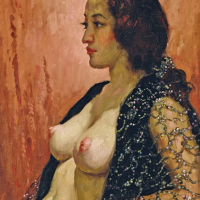35. NORMAN LINDSAY

Norman Lindsays unique position in Australian art was based on the defiant conviction that everything he produced was founded on healthy and wholesome unabashed sexual freedom. His output as a painter was prodigious and yet he may be best known for his watercolours or his etchings. He was also an art critic, philosopher, political cartoonist, poet, writer of childrens books, and sculptor. His energy is only matched by his unshakable belief in himself and his work. It was the righteousness of this belief, his work ethic and his technical skill that refuted any claim his work was anything other than high art. He was denounced by some contemporaries for vulgarity,1 or that his work was decadent. But this was part of his polemical disposition. Lindsays nudes, no matter how erotically charged may be our interpretation of them, are declared by the artist to be Art and for that reason exist outside the normal bounds of decency and taste. The cavorting females with their lovers and their attendant cast of mythological creatures, dwarfs, rogues, pirates and the occasional clergyman are allowed to go about their business secure in the knowledge that they are backed up by hundreds of years of important western art. Lindsay was an acolyte of art history, a descendant of the great Greek and Roman classical artists and their later followers Titian, Rubens, Velazquez, Boucher and Fragonard. In particular Lindsay drew on the more recent work of the Swiss painter Arnold Bcklin (1827-1901), whose enormously successful mythologies paved the way for the earthy humanity of the gods and goddesses that populate his work. Like Bcklin, Lindsay sought to realise the eternal truths of humanity by presenting his gods contemporarily, as if they are among us now. His gods are like the family next door and yet by placing them in landscape settings that retained an unmistakable flavour of the stage, he allowed them significant artistic licence to cavort.
Lindsay never did anything without giving consideration to the precedents set by classical art. In the case of his portraits the point is especially apt. Again, earthy directness blended with high levels of technical ability in rendering resulted in paintings that recall the phenomenal skills of Baroque painters such as Rembrandt and Frans Hals. In doing so, Lindsay renders his sitters and his paintings of them completely timeless. Throughout his active life Lindsay drew on numerous family members, friends and acquaintances as well as a large number of professional models to pose for him. Rita in Profile painted circa 1940 depicts one of Lindsays favourite and best-known models, Rita Lee.
she was the quietest and most reticent model who ever sat for me. She was brought to my studio by one of the minor artists here. He happened to see Rita in a restaurant and was so struck by her beauty that he introduced himself to her as an artist and asked her if she felt like sitting for him as a model. She had some sort of factory job at the time, but threw it up on finding that she could make a better, and more pleasing, living, as a model.2
Lindsay portrayed Rita nude, in period costumes, dressed as a bride, in his mythologies and history pieces. The professional and personal bond they formed is one of the great partnerships of Australian Art. The elegant simplicity of Rita in Profile testifies to this partnership and special character of the artist and of his model.
Footnotes
1. Hughes, R., The Art of Australia, Penguin, 1966, pp.84-85
2. Norman Lindsay, quoted in Bloomfield, L., Norman Lindsay: Oil Paintings 1889-1969, Odana Editions, Bungendore, 2006, p.158
Timothy Abdallah BA